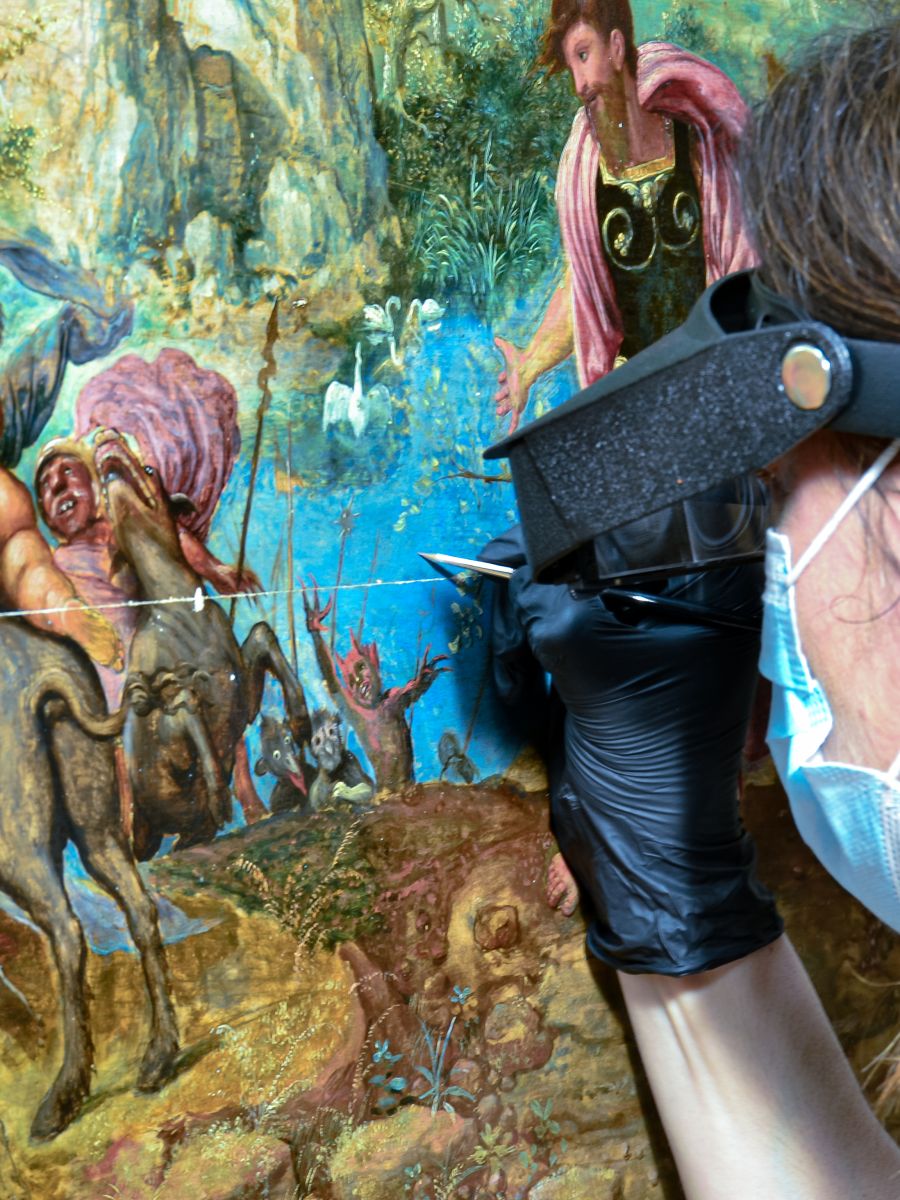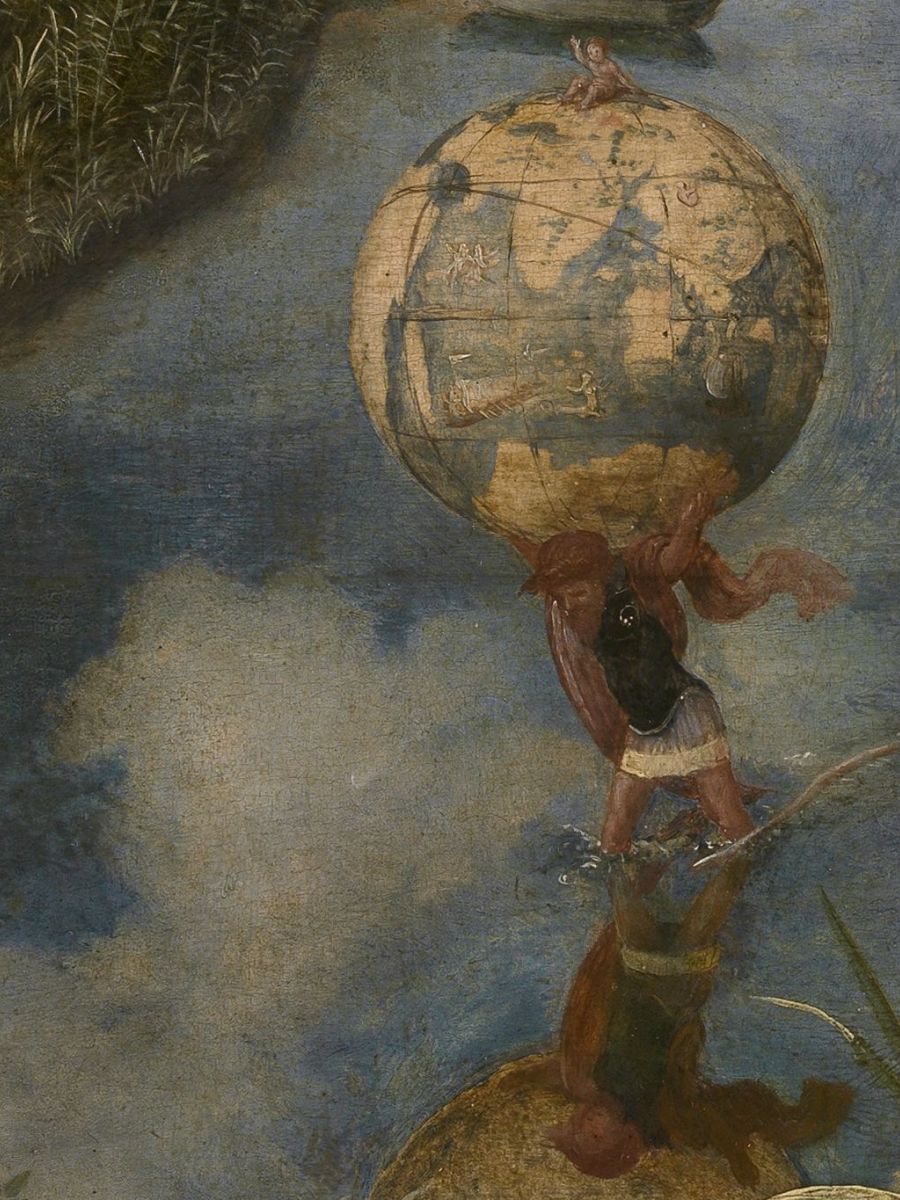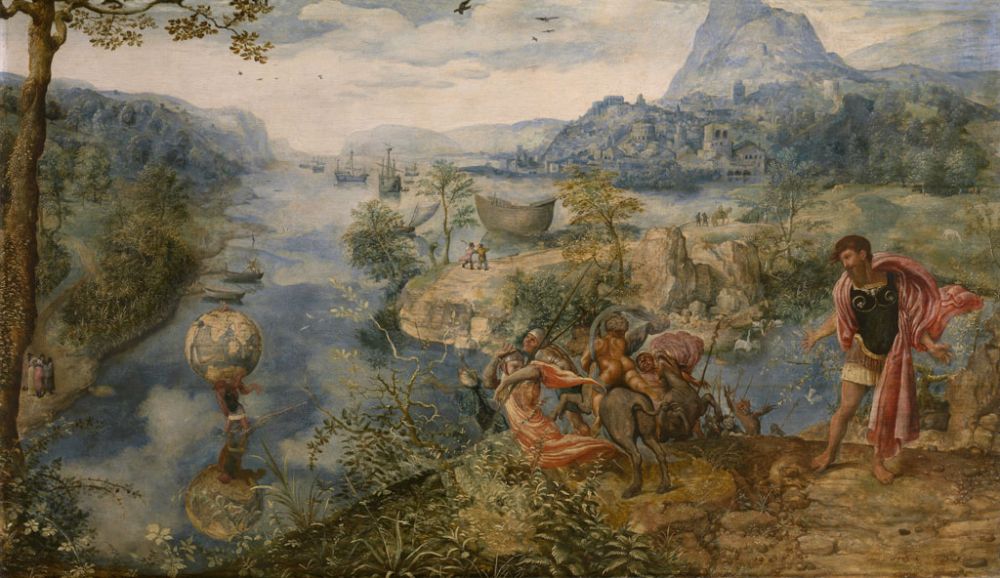Five novelties in the land of St Christopher

Paintings allowed a largely illiterate public to grasp the essentials of a story as explicitly as possible. Tales from the Bible and from history, and especially the moral lessons they taught, were a veritable guide to living. Artists worked within a tradition in which saints, for instance, could be recognized because everyone depicted them in the same way.
But you also had trendsetters like Hieronymus Bosch within that tradition, who would introduce new elements or bend the rules, which everyone would then start to imitate. Once such was this unidentified artist from the 16th century, whose version of the Legend of St Christopher in the KMSKA collection is much more original than those of his contemporaries. How come?

Christopher who?
Christopher’s story comes from the collection of saints’ lives known as the Legenda aurea or ‘Golden Legend’. Our hero is said to have been a giant who was eager to serve the most powerful ruler in the world. A king was no good, because he turned out to be afraid of demons and of Satan. And Satan flinched in turn at the sign of the cross. A hermit advised Christopher that the best way to serve the ruler to whom the cross referred would be to fast and to pray. But the giant opted for a more active alternative and began to carry people back and forth between two riverbanks like a human ferry. One day a child appeared and asked to be carried across. As he waded to the other side, Christopher found himself struggling more and more with his burden. On reaching the other side, the child vanished and the adult Christ appeared. Laden with all the sins of humankind, Jesus had been almost too heavy a load for Christopher, literally the ‘Christ-bearer’, to carry.

The pink cloak always features in contemporary images of the saint. Not so the soldier’s uniform.

Superman
It was not uncommon in the 16th century for a work of art to be treated like a kind of comic strip in which the main character appears several times. Christopher is depicted here twice, like some kind of superhero, complete with fluttering cloak.
He wards off the demons with a gesture, unlike the king’s soldiers who run away in terror. The fluttering pink cloak is a standard element in this hero’s depiction, but he is considerably more animated here than his counterparts in other contemporary paintings and he wears a uniform that suggests a Roman officer rather than some undefined saint’s robes. The costume highlights his strength and vigour, even if he struggled to cross the river.


Demonic cuddly toys
The demons that Christopher scatters with a wave of his hand thanks to his aura of Christian goodness are not the terrifying monsters that were supposed to cause sinners to repent in the 16th century. They look more like characters from Sesame Street or the Muppet Show. While the red devil seems to cry out in pain, his two companions look a little perplexed, as if wondering what all the fuss is about.

Christopher’s demonic teddy bears

and a more standard demon by Maerten de Vos
World landscape
The earliest painted landscapes were an invention of artists from our region. They served a narrative and pioneers like Joachim Patinir (c. 1480–1524) tried to cram the entire world into a single painting. ‘World landscapes’ like these were studio constructs made up of fixed pieces of stage scenery – building blocks that the artist could mix and match at will. At first sight, the painter of this St Christopher follows the same rules. All the elements are present: the meandering river, the view of a city by the water, mountains with a castle on one of the peaks.
But then he added two striking images: a ship is moored by the riverbank, mysteriously abandoned and reminiscent of traditional images of the Ark that saved Noah and his family from the Flood. The Tower of Babel, meanwhile, looms up in the centre of the village. Both these elements refer to stories from the Bible in which humanity is punished by God. They recall the medieval mappa mundi – world maps that show the route to both Jerusalem and to a virtuous life. The traveller passes all sorts of historical and biblical references along the way, the Tower of Babel among them.


Globe
Now that Christopher has temporarily assumed the Child’s burden, Christ can wave happily to the viewer. The artist has embodied all the world’s sins and problems as a literal globe. It is a double innovation here: a globe was as much a novelty as a physical object as its depiction was in a painting. The Nuremberg merchant Martin Behaim was the first to make one in 1493 and the globe shown here might be that very object. Madagascar and the tip of India are already pretty accurate, while the imaginary landmass next to India presumably represents the rest of Asia. The ocean is filled with all manner of sea creatures, as was typical of maps at the time. Danger lurks everywhere in the unknown depths or in the shape of a merman almost the size of a ship.

Placid waters
The Golden Legend states that the river where Christopher offered his ferry service was rough and dangerous. There’s no sign of that here. Far from it: the water is glassy, not a ripple in sight, making it perfect to reflect Jesus and the clouds. All the same, there is a body floating there. Does it hint at the hazards of the wild river? Infrared images of the underdrawing reveal that the corpse was not originally included – the artist added it at a later stage. There is no trace here of the hermit from the story or of Christopher’s standard attribute, a flowering palm, although we do make out a stray, bare branch beside him in the water.

Infrared image - body not present in the underdrawing.

After removal of the varnish, the river looks even bluer and smoother. P - Photographs: Rik Klein Gotink
Demoted from sainthood
Christopher was the most popularly depicted holy figure in the Middle Ages after Christ himself and the Virgin Mary. You found him everywhere. He offered protection against all manner of evils, just as he wards off the demons and has carried Christ safely to the riverbank in this painting. Almost everyone claimed him as their patron saint, from travellers, the sick, carpenters, painters, fruit-sellers, treasure-hunters and hatters to gardeners and children. Suffering from toothache? Pray to St Christopher! People to this day keep his image about them. It is said that you can’t die on a day when you have set eyes on him. For all this lasting popularity, Christopher ceased to be an official saint in 1969: the Vatican no longer considered his life-story sufficiently credible.




